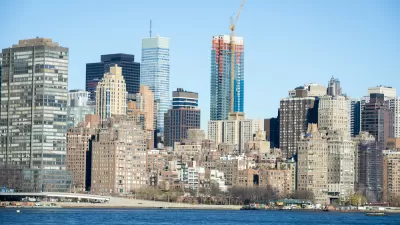Trends in Washington D.C. housing affordability is similar to other cities around the country, but is also unique in how swiftly the housing market has shifted.
"Back in 2005, before the new apartments went up in NoMa, and along 14th Street, and near the Nationals' ballpark, there was more housing in D.C. renting for less than $500 a month than for more than $1,500 [inflation-adjusted, 2012 dollars]," according to Emily Badger. Since then however, the market has been flipped upside down. "By 2012, the most expensive rental units outnumbered the cheapest ones — by more than a three-to-one ratio."
Badger explains the forces driving the change: "The changing shape of the city's housing over this short time reflects two powerful trends that are playing out in other big cities, too: Housing that was once more affordable has grown less so, while most of the new housing that's been built has catered to wealthier (and newer) residents."
Badger goes on to provide insight into a new study by the Urban Institute called "Washington D.C.: Our Changing City," which shows how critical the rental market is to understand the evolution of Washington D.C. Also cited is data from NeighborhoodInfoDC showing "that nearly every corner of the city has increased its housing supply." That new supply, however, has not been sufficient in maintaining previous levels of affordability given the large-scale influx of upper-income, childless residents.
FULL STORY: How high-cost housing conquered D.C. in a single decade

Planetizen Federal Action Tracker
A weekly monitor of how Trump’s orders and actions are impacting planners and planning in America.

Restaurant Patios Were a Pandemic Win — Why Were They so Hard to Keep?
Social distancing requirements and changes in travel patterns prompted cities to pilot new uses for street and sidewalk space. Then it got complicated.

Map: Where Senate Republicans Want to Sell Your Public Lands
For public land advocates, the Senate Republicans’ proposal to sell millions of acres of public land in the West is “the biggest fight of their careers.”

Maui's Vacation Rental Debate Turns Ugly
Verbal attacks, misinformation campaigns and fistfights plague a high-stakes debate to convert thousands of vacation rentals into long-term housing.

San Francisco Suspends Traffic Calming Amidst Record Deaths
Citing “a challenging fiscal landscape,” the city will cease the program on the heels of 42 traffic deaths, including 24 pedestrians.

California Homeless Arrests, Citations Spike After Ruling
An investigation reveals that anti-homeless actions increased up to 500% after Grants Pass v. Johnson — even in cities claiming no policy change.
Urban Design for Planners 1: Software Tools
This six-course series explores essential urban design concepts using open source software and equips planners with the tools they need to participate fully in the urban design process.
Planning for Universal Design
Learn the tools for implementing Universal Design in planning regulations.
Heyer Gruel & Associates PA
JM Goldson LLC
Custer County Colorado
City of Camden Redevelopment Agency
City of Astoria
Transportation Research & Education Center (TREC) at Portland State University
Camden Redevelopment Agency
City of Claremont
Municipality of Princeton (NJ)





























